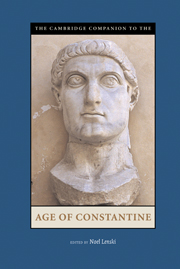Book contents
- Frontmatter
- Introduction
- 1 Sources for the History of Constantine
- Section 1 Politics and Personalities
- Section II Religion and Spiritual Life
- 5 The Impact of Constantine on Christianity
- 6 The Beginnings of Christianization
- 7 Traditional Religions
- Section III Law and Society
- Section IV Art and Culture
- Section V Empire and Beyond
- Appendix 1: Stemmata
- Appendix 2: Timeline
- Maps
- Primary Sources and Translations
- Secondary Bibliography
- Index
7 - Traditional Religions
from Section II - Religion and Spiritual Life
Published online by Cambridge University Press: 28 September 2007
- Frontmatter
- Introduction
- 1 Sources for the History of Constantine
- Section 1 Politics and Personalities
- Section II Religion and Spiritual Life
- 5 The Impact of Constantine on Christianity
- 6 The Beginnings of Christianization
- 7 Traditional Religions
- Section III Law and Society
- Section IV Art and Culture
- Section V Empire and Beyond
- Appendix 1: Stemmata
- Appendix 2: Timeline
- Maps
- Primary Sources and Translations
- Secondary Bibliography
- Index
Summary
The world in which Constantine grew up during the late third century was a world “full of gods.” It was full of gods in the sense that “religion pervaded every aspect of political and social life” and that religious life in the Roman empire encompassed an extraordinary diversity of deities and of expressions of devotion to those deities. This diversity was observable in any part of the Roman empire, but even in the late third century, when it was increasingly marginalised as a locus of political power, it was the city of Rome which continued to offer the most conspicuous and concentrated exemplar of this phenomenon.
Traditional Religions of Rome: An Introductory Tour
Had the young Constantine visited the city of Rome in the 280s, he would have been confronted by a vast array of temples and shrines, their history reflecting the evolution of Roman power over the course of a millennium, and he would no doubt have marvelled at them in the same way that his son was to do during a famous visit three-quarters of a century later (see Map 3.1). Entering the traditional heart of public life in the city, the forum, his gaze might well have been drawn first to the temple of Jupiter, which occupied a commanding position on the Capitoline hill overlooking the forum and was still regarded by one fourth-century writer as “the most magnificent building in the whole world.”
- Type
- Chapter
- Information
- The Cambridge Companion to the Age of Constantine , pp. 159 - 180Publisher: Cambridge University PressPrint publication year: 2005
- 3
- Cited by

